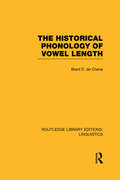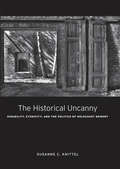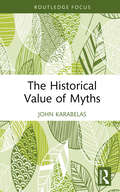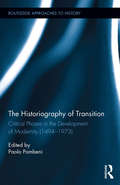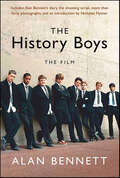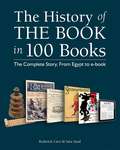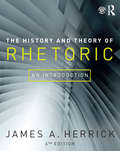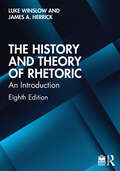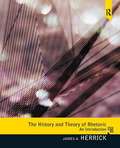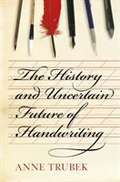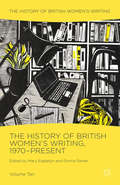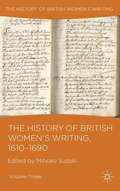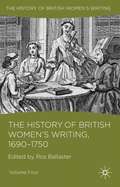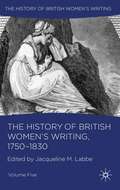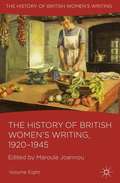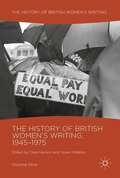- Table View
- List View
The Historical Phonology of Vowel Length (Routledge Library Editions: Linguistics)
by Brent de CheneData from a variety of languages are offered in support of the claim that although there are several processes by which languages commonly add to an already existing stock of long vowels, there is only one mechanism by which a language without a distinction of vocalic length commonly introduces such a distinction. This mechanism is the coalescence of vowel sequences, typically after loss of intervocalic consonants. This book examines vowels lengths, their differences and their effects on language.
The Historical Renaissance: New Essays on Tudor and Stuart Literature
by Heather Dubrow Richard SprierInciteful essays with substantial bibliographies.
The Historical Uncanny: Disability, Ethnicity, and the Politics of Holocaust Memory
by Susanne C. KnittelThe Historical Uncanny explores how certain memories become inscribed into the heritage of a country or region while others are suppressed or forgotten. In response to the erasure of historical memories that discomfit a public’s self-understanding, this book proposes the historical uncanny as that which resists reification precisely because it cannot be assimilated to dominant discourses of commemoration.Focusing on the problems of representation and reception, the book explores memorials for two marginalized aspects of Holocaust: the Nazi euthanasia program directed against the mentally ill and disabled and the Fascist persecution of Slovenes, Croats, and Jews in and around Trieste. Reading these memorials together with literary and artistic texts, Knittel redefines “sites of memory” as assemblages of cultural artifacts and discourses that accumulate over time; they emerge as a physical and a cultural space that is continually redefined, rewritten, and re-presented.In bringing perspectives from disability studies and postcolonialism to the question of memory, Knittel unsettles our understanding of the Holocaust and its place in the culture of contemporary Europe.
The Historical Value of Myths
by John KarabelasThis book explores the connection between history and mythology by engaging with myths not as allegories or falsehoods, but as representations of historical experience. Historical approaches to myth are often absent from discussions of mythology, which favour symbolic and psychological interpretations. This analysis traces certain episodes of myths’ complex ancestries, from when their relationship with history could not so easily be severed, to subsequent attempts, which misunderstood myths as confused, undeveloped lenses for humanity to view the world. Drawing on the works of English philosopher R.G. Collingwood and the Romanticism movement, the book argues for the expansion of methodological approaches to myths. It explores the ways in which myths have served as clues for the history of civilization and humanity’s ever-changing complexities. The Historical Value of Myths is an illuminating read for advanced undergraduates, postgraduates, and researchers in the fields of mythology, the philosophy of history, and anthropology.
The Historical Web and Digital Humanities: The Case of National Web Domains (Digital Research in the Arts and Humanities)
by Niels Brügger Ditte LaursenThe Historical Web and Digital Humanities fosters discussions between the Digital Humanities and web archive studies by focussing on one of the largest entities of the web, namely national and transnational web domains such as the British, French, or European web. <P><P>With a view to investigating whether, and how, web studies and web historiography can inform and contribute to the Digital Humanities, this volume contains a number of case studies and methodological and theoretical discussions that both illustrate the potential of studying the web, in this case national web domains, and provide an insight into the challenges associated with doing so. Commentary on and possible solutions to these challenges are debated within the chapters and each one contributes in its own way to a web history in the making that acknowledges the specificities of the archived web. <P><P>The Historical Web and Digital Humanities will be essential reading for those with an interest in how the past of the web can be studied, as well as how Big Data approaches can be applied to the archived web. As a result, this volume will appeal to academics and students working and studying in the fields of Digital Humanities, internet and media studies, history, cultural studies, and communication.
The Histories of Some of the Penitents in the Magdalen House (Chawton House Library: Women's Novels)
by Jennie Batchelor Megan HiattFirst published in 1759, this novel aims to promote the cause of the Magdalen House, a charity which sought to rehabilitate prostitutes by fitting them for a life of virtuous industry. It challenges long-standing prejudices against prostitutes by presenting them as victims of inadequate education, male libertinism and sexual double standards.
The Historiography of Transition: Critical Phases in the Development of Modernity (1494-1973) (Routledge Approaches to History)
by Paolo PombeniDefining a “historic transition” means understanding how the complex system of intellectual, social, and material structures formed that determined the transition from a certain “universe” to a “new universe,” where the old explanations were radically rethought. In this book, a group of historians with specializations ranging from the sixteenth to the twentieth centuries and across political, religious, and social fields, attempt a reinterpretation of “modernity” as the new “Axial Age.”
The History Behind Game of Thrones: The North Remembers
by David C. WeinczokThe true history behind the hit HBO fantasy show and George R. R. Martin&’s bestselling Fire and Ice series. A wall in the distant north cuts the world in two. Ruthless sea-born warriors raid the coasts from their war galleys. A young nobleman and his kin are slaughtered under a banner of truce within a mighty castle. A warrior king becomes a legend when he smites his foe with one swing of his axe during a nation-forging battle. Yet this isn&’t Westeros—it&’s Scotland. Game of Thrones is history re-imagined as fantasy. The History Behind Game of Thrones turns the tables, using George R. R. Martin&’s extraordinary fictional universe as a way to understand the driving forces and defining moments from Scotland&’s story. Why were castles so important? Was there a limit to the powers a medieval king could use—or abuse? What was the reality of being under siege? Was there really anything that can compare to the destructive force of dragons? By joining forces, Westeros and Scotland hold the answers. Writer and presenter David C. Weinczok draws on a vast array of characters, events, places, and themes from Scottish history that echo Game of Thrones at every dramatic turn. Visit the castle where the real Red Wedding transpired, encounter the fearsome historical tribes beyond Rome&’s great wall, learn how a blood-red heart became the most feared sigil in Scotland, and much more. By journey&’s end, the cogs in the wheels of Martin&’s world and Scottish history will be laid bare, as well as the stories of those who tried to shape—and sometimes even break—them.
The History Boys: The Film
by Alan BennettNow a major motion picture from Fox Searchlight Pictures, The History Boys: The Film contains Alan Bennett's diary of the filming, the shooting script, and an introduction by director Nicholas Hytner, as well as an extensive plate section that includes a look behind the scenes and stills from the film.An unruly bunch of bright, funny sixth-form (or senior) boys in a British boys' school are, as such boys will be, in pursuit of sex, sport, and a place at a good university, generally in that order. In all their efforts, they are helped and hindered, enlightened and bemused, by a maverick English teacher who seeks to broaden their horizons in sometimes undefined ways, and a young history teacher who questions the methods, as well as the aim, of their schooling. In The History Boys, Alan Bennett evokes the special period and place that the sixth form represents in an English boy's life. In doing so, he raises not only universal questions about the nature of history and how it is taught but also questions about the purpose of education today.
The History Of The Book In 100 Books: The Complete Story, From Egypt To E-book
by Roderick Cave Sara AyadIn The History of the Book in 100 Books, the author explores 100 books that have played a critical role in the creation and expansion of books and all that they bring -- literacy, numeracy, expansion of knowledge, religion, political theory, oppression, liberation, and much more. The book is ordered chronologically and divided thematically. Each of the 100 sections focuses on one book that represents a particular development in the evolution of books and in turn, world history and society. Abundant photographs inform and embellish.
The History and Theory of Rhetoric: An Introduction
by James A. HerrickThe History and Theory of Rhetoric offers an accessible discussion of the history of rhetorical studies in the Western tradition, from ancient Greece to contemporary American and European theorists. By tracing the historical progression of rhetoric from the Greek Sophists of the 5th Century B. C. to contemporary studies--such as the rhetoric of science and feminist rhetoric--this concise yet comprehensive text helps students better understand what rhetoric is and what unites differing rhetorical theories throughout history.
The History and Theory of Rhetoric: An Introduction
by James A. HerrickBy tracing the traditional progression of rhetoric from the Greek Sophists to contemporary theorists, this textbook gives students a conceptual framework for evaluating and practicing persuasive writing and speaking in a wide range of settings and in both written and visual media. The book’s expansive historical purview illustrates how persuasive public discourse performs essential social functions and shapes our daily worlds, drawing on the ideas of some of history’s greatest thinkers and theorists. The seventh edition includes greater attention to non-Western rhetorics, feminist rhetorics, the rhetoric of science, and European and American critical theory. Known for its clear writing style and contemporary examples throughout, The History and Theory of Rhetoric emphasizes the relevance of rhetoric to today’s students. This revised edition serves as a core textbook for rhetoric courses in both English and communication programs covering both the historical tradition of rhetoric and contemporary rhetoric studies. This edition includes an instructor’s manual and practice quizzes for students at www.routledge.com/cw/herrick
The History and Theory of Rhetoric: An Introduction
by James A. Herrick Luke WinslowBy tracing the traditional progression of rhetoric from the Greek Sophists to contemporary theorists, this updated eighth edition gives students a conceptual framework for evaluating and practicing persuasive writing and speaking in a wide range of settings, including written, visual, and digital media.Through an expansive historical purview, the book illustrates how persuasive public discourse performs essential social functions and shapes our societies, drawing on the ideas of many of history’s greatest thinkers and theorists. This new edition includes an integrated exploration of non-Western rhetorics, an updated account of contemporary rhetoric, and an enhanced analysis of rhetorical theory in a digital age. Known for its clear writing style and contemporary examples throughout, The History and Theory of Rhetoric emphasizes the relevance of rhetoric to today’s students.This revised edition serves as a core textbook for rhetoric courses in both English and communication programs, covering both the historical tradition of rhetoric and contemporary rhetoric studies.A suite of online resources, including a detailed instructor’s manual, PowerPoint slides, and videos from Dr. Winslow, can be found on the Instructor and Student Resources website at www.routledgelearning.com/historyofrhetoric.
The History and Theory of Rhetoric: An Introduction (Subscription)
by James A. HerrickThe History and Theory of Rhetoric offers discussion of the history of rhetorical studies in the Western tradition, from ancient Greece to contemporary American and European theorists that is easily accessible to students. By tracing the historical progression of rhetoric from the Greek Sophists of the 5th Century B.C. all the way to contemporary studies-such as the rhetoric of science and feminist rhetoric-this comprehensive text helps students understand how persuasive public discourse performs essential social functions and shapes our daily worlds. Students gain conceptual framework for evaluating and practicing persuasive writing and speaking in a wide range of settings and in both written and visual media. Known for its clear writing style and contemporary examples throughout, The History and Theory of Rhetoric emphasizes the relevance of rhetoric to today's students.
The History and Uncertain Future of Handwriting
by Anne TrubekIn the digital age of instant communication, handwriting is less necessary than ever before, and indeed fewer and fewer school children are being taught how to write in cursive. Signatures--far from John Hancock’s elegant model--have become scrawls. In her recent and widely discussed and debated essays, the author argues that the decline and even elimination of handwriting from daily life does not signal a decline in civilization, but rather the next stage in the evolution of communication. In this book, the author uncovers the long and significant impact handwriting has had on culture and humanity--from the first recorded handwriting on the clay tablets of the Sumerians some four thousand years ago and the invention of the alphabet as we know it, to the rising value of handwritten manuscripts today. Each innovation over the millennia has threatened existing standards and entrenched interests: Indeed, in ancient Athens, Socrates and his followers decried the very use of handwriting, claiming memory would be destroyed; while Gutenberg’s printing press ultimately overturned the livelihood of the monks who created books in the pre-printing era. And yet new methods of writing and communication have always appeared. Establishing a novel link between our deep past and emerging future. The author offers a colorful lens through which to view our shared social experience.
The History of Basque (Current Issues In Linguistic Theory Ser. #131)
by R. L. TraskBasque is the sole survivor of the very ancient languages of Western Europe. This book, written by an internationally renowned specialist in Basque, provides a comprehensive survey of all that is known about the prehistory of the language, including pronunciation, the grammar and the vocabulary. It also provides a long critical evaluation of the search for its relatives, as well as a thumbnail sketch of the language, a summary of its typological features, an external history and an extensive bibliography.
The History of British Women's Writing, 1970-Present: Volume Ten (History of British Women's Writing)
by Mary Eagleton Emma ParkerThis book maps the most active and vibrant period in the history of British women's writing. Examining changes and continuities in fiction, poetry, drama, and journalism, as well as women's engagement with a range of literary and popular genres, the essays in this volume highlight the range and diversity of women's writing since 1970.
The History of British Women’s Writing, 1610–1690
by Mihoko SuzukiDuring the seventeenth century, in response to political and social upheavals such as the English Civil Wars, women produced writings in both manuscript and print. This volume represents recent scholarship that has uncovered new texts as well as introduced new paradigms to further our understanding of women's literary history during this period.
The History of British Women’s Writing, 1690–1750: Volume Four
by Ros BallasterThis volume charts the most significant changes for a literary history of women in a period that saw the beginnings of a discourse of 'enlightened feminism'. It reveals that women engaged in forms old and new, seeking to shape and transform the culture of letters rather than simply reflect or respond to the work of their male contemporaries.
The History of British Women’s Writing, 1750–1830
by Jacqueline M. LabbeThis period witnessed the first full flowering of women's writing in Britain. This illuminating volume features leading scholars who draw upon the last 25 years of scholarship and textual recovery to demonstrate the literary and cultural significance of women in the period, discussing writers such as Austen, Wollstonecraft and Mary Shelley.
The History of British Women’s Writing, 1920–1945
by Maroula JoannouThe historical period from 1920 to 1945 is coterminous with the great achievements of literary Modernism dating approximately from the annus mirabilis of 1922, which saw T. S. Eliot's The Waste Land and James Joyce's Ulysses, to the publication of Joyce's Finnegans Wake at the apex of 'high Modernism' in 1939. The majority of women whose work is discussed in volume eight of The History of British Women's Writing series do not fit into a recognized version of the modernist canon. Their complex and often troubled relationship to modernity – as readers, consumers, and travellers at home and abroad – requires new critical frameworks in which to discuss their writing as well as a revision of the territory that has been staked out as the preserve of Modernism by critical theory and practice. This book, now available in paperback, serves as a superb new mapping and overview of women's writing between the two world wars written by leading scholars from Britain and the United States. Topics range from the feminine middlebrow novel to Virginia Woolf's modernist aesthetics, from women's literary journalism to best-selling crime fiction, from West End drama to the literature of Scotland, Ireland and Wales and poetry in small magazines.
The History of British Women’s Writing, 1945–1975
by Clare Hanson Susan WatkinsThis volume reshapes our understanding of British literary culture from 1945-1975 by exploring the richness and diversity of women's writing of this period. Essays by leading scholars reveal the range and intensity of women writers' engagement with post-war transformations including the founding of the Welfare State, the gradual liberalization of attitudes to gender and sexuality and the reconfiguration of Britain and the empire in the context of the Cold War. Attending closely to the politics of form, the sixteen essays range across 'literary', 'middlebrow' and 'popular' genres, including espionage thrillers and historical fiction, children's literature and science fiction, as well as poetry, drama and journalism. They examine issues including realism and experimentalism, education, class and politics, the emergence of 'second-wave' feminism, responses to the Holocaust and mass migration and diaspora. The volume offers an exciting reassessment of women's writing at a time of radical social change and rapid cultural expansion.
The History of British Women�s Writing, 700�1500
by Diane Watt Liz Herbert McavoyThis volume focuses on women's literary history in Britain between 700 and 1500, a period traditionally marginalized in accounts of women's writing in English. Such marginalization, the editors argue, has been brought about in part by the erroneous assumption that there were no women writers operating in Britain before the emergence of Julian of Norwich and Margery Kempe in the fourteenth and fifteenth centuries. The History of British Women's Writing 700-1500 therefore vigorously refutes this premise by focusing on a wide range of texts written by, for, and in collaboration with women from the Anglo-Saxon period through to the beginning of the sixteenth century. By also considering women's writing in the context of the deeply multicultural and multilingual milieu which was medieval 'Britain', it uncovers a wide range of women's literary activity undertaken in Latin, Welsh and Anglo-Norman as well as in the English vernacular and, in so doing, demands a rethinking of the long-established traditions of 'English' literary history and even the concept of 'writing' itself. "
The History of Chinese Ceramics (China Academic Library)
by Lili FangAdopting the perspective of anthropology of art and combining it with global academic insights, this book helps the readers to recognize that “history is, in great measure, the record of human activity which spreads from the local to the regional, from the regional to the global, and from the global to the universal.” Readers will learn that China was not only the first country to create porcelain, but also the first to export it to the world, both the products and its techniques. Therefore, the history of Chinese ceramics reflects the history of Chinese foreign trade on the one hand and depicts the expansion of Chinese ceramic techniques and cultures on the other. In addition to ceramics types, molds, decoration, and techniques, the book analyzes the spiritual impacts and aesthetic conceptions embodied in the utensils of daily use by the Chinese literati. Therefore, it reaches the conclusion that ideological systems and not technological systems are what bring about social revolutions. In addition, the book is richly illustrated with pictures of earthenware and finely glazed pieces from later periods.
The History of Chinese Phonology: Volume 1 (Wang Li Linguistics Series)
by Wang LiAs the first volume of a two-volume set on the history of Chinese phonology, this book introduces the basics of the discipline and charts the history of phonology from the pre-Qin period to the Song dynasty.Based on abundant phonological materials, the author divides the history of Chinese phonology into nine historical periods, which helps illuminate its evolutions and principles. The first part of the book explains the fundamental concepts of the history and studies of Chinese phonology, including the rhyme dictionary, the rhyme table, dialect, and methodology, as well as fanqie, rhyme sets, division, and articulation. The second part discusses Chinese phonology across the first six periods, from the pre-Qin era (before 206 BCE) to the Song dynasty (960–1279), elucidating the phonological development and characteristics in terms of initials, rhyme groups, and tones.This title will be of great value for scholars and students studying Chinese phonology, Chinese linguistics, and readers interested in the essence of rhyming behind classic Chinese lyrics, poetry, drama, and other forms of verse.
